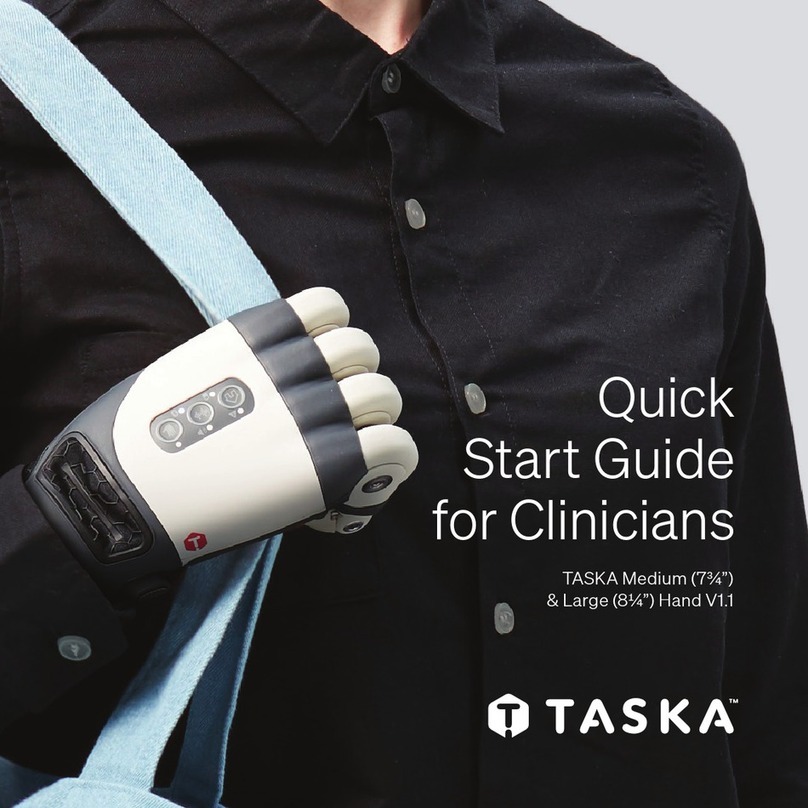
8 9
The battery charge does not
last a full day.
Possible reasons :
• the batteries are not fully charged. A full charge
takes four hours.
• the batteries have been in use for more than one
year.
• the “anti-slip” feature is on – this uses a lot of
battery. Turn off this feature if you do not need it.
• the “Close” signal is being used unnecessarily and
is using the battery. Once the hand has closed and
has a solid grip on an object, turn off the “Close”
signal.
• Bluetooth has been left on and is using the battery.
Turn off Bluetooth when you do not need it.
Contact your clinician if the problem continues.
Problem What to do
Fault (“!”) LED comes on, and
the hand stops working
This might mean:
a) the hand is too hot inside.
b) there is water inside the hand.
Turn the hand off, leave it for 5 to 10 minutes, then turn
it on again.
The fault (“!”) light come on
repeatedly and the hand stops
working.
Contact your clinician, who will help you identify and fix
the problem.
The battery light flashes every
10 seconds.
The batteries have only 10% power remaining. Recharge
the batteries as soon as possible.
The battery light is flashing
even though the batteries
were recently charged.
If you know the batteries are charged but the battery
light keeps flashing, check that you are using TASKA
batteries. Not using batteries supplied by TASKA is a
common cause of this problem.
You can turn off the low battery light using the HandCal
software (see the HandCal user guide).
The battery light stays on and
the hand stops working.
The batteries have gone flat and need to be recharged.
The hand does not respond to
control signals.
Make sure the:
• hand is turned on.
• batteries have sufficient charge.
• charging point is disconnected from a charger.
• hand is connected properly at the wrist.
• current grip is not a static grip.
• EMG disable function is not active.
The connections from the sensor(s) may have become
loose. To check if this is the case:
1) Turn on the hand while holding down the EMG
trigger button.
2) Try to open and close the hand as normal.
This should make a light for each sensor flash:
• if one or both of the lights do not flash, there is
a problem such as a broken wire.
• if one or both of the lights stay on all the time,
the signal is too strong.
Contact your clinician if the problem continues.
The thumb does not line up
correctly in the standard grips.
1) Turn the hand off.
2) Make sure the fingers are free to move through
their full range of movement.
3) Turn the hand on.
The first finger may be out of place after spreading the
fingers widely. You can use your other hand to move this
finger back into position.
Compliance statements
See the website www.taskaprosthetics.com/compliance for a full list of
compliance statements and declarations.
TASKA Hand: TASKA-XXXXXX
General Safety:
IEC60601-1-1:2012
• Protection against electrical shock – Class II.
• Not suitable for use in the presence of flammable gases.
IEC 60601-1-2:2014
Rated to CISPR 11 (Class B): Suitable for use in a Home Healthcare and
Professional Healthcare Facility.
Protection Rating against ingress of water and dust:
IP67
Intentional RF transmitter (Bluetooth RF transmitter):
Complies with FCC title 47 part 15
Contains Transmitter Module FCC ID: QOQBLE113
Contains Transmitter Module IC: 5123A-BGTBLE113
FCC RF Radiation Exposure Statement:
This equipment complies with FCC radiation exposure limits set forth for an
uncontrolled environment. End users must follow the specific operating
instructions for satisfying RF exposure compliance. This transmitter meets both
portable and mobile limits as demonstrated in the RF Exposure Analysis. This
transmitter must not be co-located or operate in conjunction with any other
antenna or transmitter except in accordance with FCC multi-transmitter product
procedures.
IC Statements:
This device complies with Industry Canada license-exempt RSS standard(s).
Operation is subject to the following two conditions: (1) this device may not
cause interference, and (2) this device must accept any interference, including
interference that may cause undesired operation of the device.
Troubleshooting guide



























